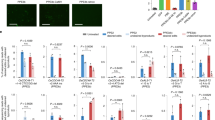Abstract
Prime editing, a CRISPR-Cas9-derived precise genome editing strategy, was recently developed to introduce targeted indels and all 12 types of point mutations without DNA double-strand breaks or donor DNA. The prime editing systems have been adopted for precision genome editing in crops including rice, wheat, maize, and tomato, which substantially expands the scope and capabilities of precision plant breeding. Here, we describe a fast and efficient method for construction of prime editing vectors based on Gateway assembly and efficiency assessment of prime editors through transient expression analyses in rice protoplasts.
Access this chapter
Tax calculation will be finalised at checkout
Purchases are for personal use only
Similar content being viewed by others
References
Kim YG, Cha J, Chandrasegaran S (1996) Hybrid restriction enzymes: zinc finger fusions to Fok I cleavage domain. Proc Natl Acad Sci U S A 93(3):1156–1160. https://doi.org/10.1073/pnas.93.3.1156
Miller JC et al (2011) A TALE nuclease architecture for efficient genome editing. Nat Biotechnol 29(2):143–148. https://doi.org/10.1038/nbt.1755
**ek M, Chylinski K, Fonfara I, Hauer M, Doudna JA, Charpentier E (2012) A programmable dual-RNA–guided DNA endonuclease in adaptive bacterial immunity. Science 337(6096):816–821. https://doi.org/10.1126/science.1225829
Lees-Miller SP, Meek K (2003) Repair of DNA double strand breaks by non-homologous end joining. Biochimie 85(11):1161–1173. https://doi.org/10.1016/j.biochi.2003.10.011
Sfeir A, Symington LS (2015) Microhomology-mediated end joining: a Back-up survival mechanism or dedicated pathway? Trends Biochem Sci 40(11):701–714. https://doi.org/10.1016/j.tibs.2015.08.006
Liang F, Han M, Romanienko PJ, Jasin M (1998) Homology-directed repair is a major double-strand break repair pathway in mammalian cells. Proc Natl Acad Sci U S A 95(9):5172–5177. https://doi.org/10.1073/pnas.95.9.5172
Jeggo PA (1998) DNA breakage and repair. Adv Genet 38:185–218
Kosicki M, Tomberg K, Bradley A (2018) Repair of double-strand breaks induced by CRISPR–Cas9 leads to large deletions and complex rearrangements. Nat Biotechnol 36(8):765–771. https://doi.org/10.1038/nbt.4192
Komor AC, Kim YB, Packer MS, Zuris JA, Liu DR (2016) Programmable editing of a target base in genomic DNA without double-stranded DNA cleavage. Nature 533:420
Gaudelli NM et al (2017) Programmable base editing of A•T to G•C in genomic DNA without DNA cleavage. Nature 551(7681):464–471. https://doi.org/10.1038/nature24644
Zhao D et al (2020) Glycosylase base editors enable C-to-A and C-to-G base changes. Nat Biotechnol 39(1):35–40. https://doi.org/10.1038/s41587-020-0592-2
Anzalone AV et al (2019) Search-and-replace genome editing without double-strand breaks or donor DNA. Nature 576(7785):7785. https://doi.org/10.1038/s41586-019-1711-4
Liu Y, Kao H-I, Bambara RA (2004) Flap endonuclease 1: a central component of DNA metabolism. Annu Rev Biochem 73(1):589–615. https://doi.org/10.1146/annurev.biochem.73.012803.092453
Keijzers G, Bohr VA, Rasmussen LJ (2015) Human exonuclease 1 (EXO1) activity characterization and its function on flap structures. Biosci Rep 35(3):e00206. https://doi.org/10.1042/BSR20150058
Tang X et al (2020) Plant prime editors enable precise gene editing in Rice cells. Mol Plant 13(5):667–670. https://doi.org/10.1016/j.molp.2020.03.010
Lin Q et al (2020) Prime genome editing in rice and wheat. Nat Biotechnol 38(5):582–585. https://doi.org/10.1038/s41587-020-0455-x
Xu R, Li J, Liu X, Shan T, Qin R, Wei P (2020) Development of plant prime-editing systems for precise genome Editing. Plant Commun 1(3):100043. https://doi.org/10.1016/j.xplc.2020.100043
Butt H, Rao GS, Sedeek K, Aman R, Kamel R, Mahfouz M (2020) Engineering herbicide resistance via prime editing in rice. Plant Biotechnol J 18(12):2370–2372. https://doi.org/10.1111/pbi.13399
Li H, Li J, Chen J, Yan L, **a L (2020) Precise modifications of both exogenous and endogenous genes in rice by prime editing. Mol Plant 13(5):671–674. https://doi.org/10.1016/j.molp.2020.03.011
Xu W et al (2020) Versatile nucleotides substitution in plant using an improved prime editing system. Mol Plant 13(5):675–678. https://doi.org/10.1016/j.molp.2020.03.012
Lu Y et al (2020) Precise genome modification in tomato using an improved prime editing system. Plant Biotechnol J 19(3):415–417. https://doi.org/10.1111/pbi.13497
Chow RD, Chen JS, Shen J, Chen S (2021) A web tool for the design of prime-editing guide RNAs. Nat Biomed Eng 5:190–194. https://doi.org/10.1038/s41551-020-00622-8
Hsu JY et al (2020) PrimeDesign software for rapid and simplified design of prime editing guide RNAs. bioRxiv, p. 2020.05.04.077750. https://doi.org/10.1101/2020.05.04.077750
“Automated design of CRISPR prime editors for thousands of human pathogenic variants | bioRxiv.” https://doi.org/10.1101/2020.05.07.083444v1. Accessed 26 Nov 2020
Clement K et al (2019) CRISPResso2 provides accurate and rapid genome editing sequence analysis. Nat Biotechnol 37(3):224–226. https://doi.org/10.1038/s41587-019-0032-3
Park J, Lim K, Kim J-S, Bae S (2017) Cas-analyzer: an online tool for assessing genome editing results using NGS data. Bioinformatics 33(2):286–288. https://doi.org/10.1093/bioinformatics/btw561
Acknowledgments
This work was supported by the National Science Foundation Plant Genome Research Program (award no. IOS-1758745 and IOS-2029889) and the U.S. Department of Agriculture Biotechnology Risk Assessment Grant Program (award no. 2018-33522-28789 and 2020-33522-32274).
Author information
Authors and Affiliations
Corresponding author
Editor information
Editors and Affiliations
Rights and permissions
Copyright information
© 2021 The Author(s), under exclusive license to Springer Science+Business Media, LLC, part of Springer Nature
About this protocol
Cite this protocol
Sretenovic, S., Pan, C., Qi, Y. (2021). Assembly and Assessment of Prime Editing Systems for Precise Genome Editing in Plants. In: Islam, M.T., Molla, K.A. (eds) CRISPR-Cas Methods. Springer Protocols Handbooks. Humana, New York, NY. https://doi.org/10.1007/978-1-0716-1657-4_7
Download citation
DOI: https://doi.org/10.1007/978-1-0716-1657-4_7
Published:
Publisher Name: Humana, New York, NY
Print ISBN: 978-1-0716-1656-7
Online ISBN: 978-1-0716-1657-4
eBook Packages: Springer Protocols




